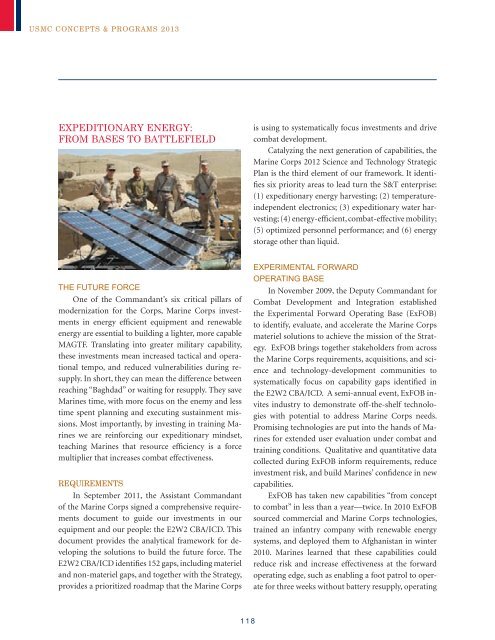USMC Concepts & Programs 2013 - Defense Innovation Marketplace
USMC Concepts & Programs 2013 - Defense Innovation Marketplace
USMC Concepts & Programs 2013 - Defense Innovation Marketplace
You also want an ePaper? Increase the reach of your titles
YUMPU automatically turns print PDFs into web optimized ePapers that Google loves.
<strong>USMC</strong> <strong>Concepts</strong> & <strong>Programs</strong> <strong>2013</strong><br />
Expeditionary Energy:<br />
From Bases to Battlefield<br />
is using to systematically focus investments and drive<br />
combat development.<br />
Catalyzing the next generation of capabilities, the<br />
Marine Corps 2012 Science and Technology Strategic<br />
Plan is the third element of our framework. It identifies<br />
six priority areas to lead turn the S&T enterprise:<br />
(1) expeditionary energy harvesting; (2) temperatureindependent<br />
electronics; (3) expeditionary water harvesting;<br />
(4) energy-efficient, combat-effective mobility;<br />
(5) optimized personnel performance; and (6) energy<br />
storage other than liquid.<br />
The Future Force<br />
One of the Commandant’s six critical pillars of<br />
modernization for the Corps, Marine Corps investments<br />
in energy efficient equipment and renewable<br />
energy are essential to building a lighter, more capable<br />
MAGTF. Translating into greater military capability,<br />
these investments mean increased tactical and operational<br />
tempo, and reduced vulnerabilities during resupply.<br />
In short, they can mean the difference between<br />
reaching “Baghdad” or waiting for resupply. They save<br />
Marines time, with more focus on the enemy and less<br />
time spent planning and executing sustainment missions.<br />
Most importantly, by investing in training Marines<br />
we are reinforcing our expeditionary mindset,<br />
teaching Marines that resource efficiency is a force<br />
multiplier that increases combat effectiveness.<br />
Requirements<br />
In September 2011, the Assistant Commandant<br />
of the Marine Corps signed a comprehensive requirements<br />
document to guide our investments in our<br />
equipment and our people: the E2W2 CBA/ICD. This<br />
document provides the analytical framework for developing<br />
the solutions to build the future force. The<br />
E2W2 CBA/ICD identifies 152 gaps, including materiel<br />
and non-materiel gaps, and together with the Strategy,<br />
provides a prioritized roadmap that the Marine Corps<br />
Experimental Forward<br />
Operating Base<br />
In November 2009, the Deputy Commandant for<br />
Combat Development and Integration established<br />
the Experimental Forward Operating Base (ExFOB)<br />
to identify, evaluate, and accelerate the Marine Corps<br />
materiel solutions to achieve the mission of the Strategy.<br />
ExFOB brings together stakeholders from across<br />
the Marine Corps requirements, acquisitions, and science<br />
and technology-development communities to<br />
systematically focus on capability gaps identified in<br />
the E2W2 CBA/ICD. A semi-annual event, ExFOB invites<br />
industry to demonstrate off-the-shelf technologies<br />
with potential to address Marine Corps needs.<br />
Promising technologies are put into the hands of Marines<br />
for extended user evaluation under combat and<br />
training conditions. Qualitative and quantitative data<br />
collected during ExFOB inform requirements, reduce<br />
investment risk, and build Marines’ confidence in new<br />
capabilities.<br />
ExFOB has taken new capabilities “from concept<br />
to combat” in less than a year—twice. In 2010 ExFOB<br />
sourced commercial and Marine Corps technologies,<br />
trained an infantry company with renewable energy<br />
systems, and deployed them to Afghanistan in winter<br />
2010. Marines learned that these capabilities could<br />
reduce risk and increase effectiveness at the forward<br />
operating edge, such as enabling a foot patrol to operate<br />
for three weeks without battery resupply, operating<br />
118

















